
John W. Potter, 1918-2013: Former Toledo mayor initiated downtown development
10/6/2013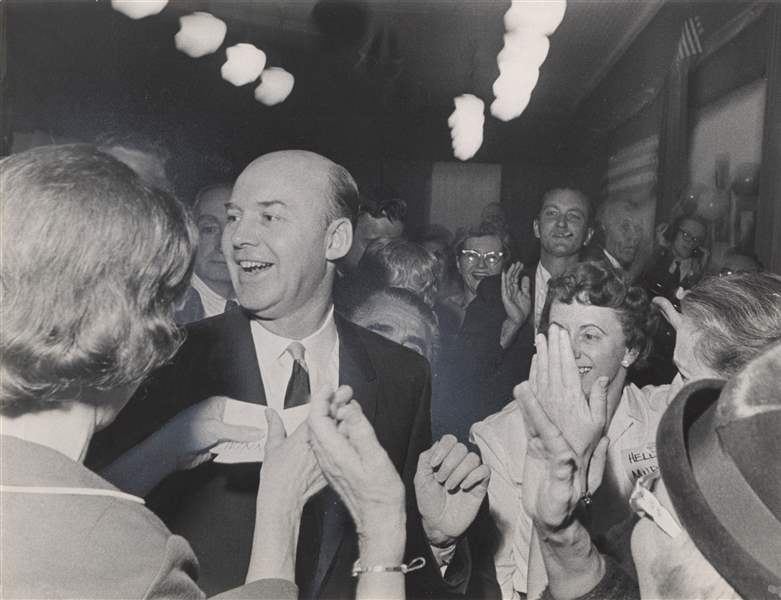
Mayor John Potter campaigns in 1965. In the 1960s, Toledo enjoyed great expansion: Its land size nearly doubled, its population grew 22 percent, and jobs rose from 181,000 to 244,000.
THE BLADE
Buy This Image
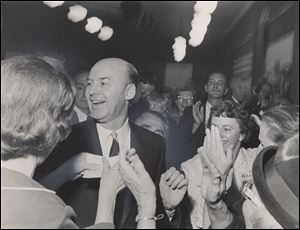
Mayor John Potter campaigns in 1965. In the 1960s, Toledo enjoyed great expansion: Its land size nearly doubled, its population grew 22 percent, and jobs rose from 181,000 to 244,000.
Retired U.S. District Judge John W. Potter, who died Thursday in Toledo Hospital at age 94, presided as Toledo’s mayor during a time when the city’s boundaries and job market expanded, but he ran afoul of voter anger over an anti-discrimination housing ordinance.
Judge Potter, formerly of the Old Orchard neighborhood in West Toledo, lived in Swan Creek Retirement Village since 2008. His daughter, Carolyn Hoyt, said he died of complications from a fractured hip.
“He really fought the long fight. He had a great desire. He was full of life right up to the end,” she said.
An Army veteran who fought in the World War II European campaign after the D-Day invasion, Judge Potter was known for having a natural charm and humor.
“He was just a good-natured person,” his daughter said.
A lifelong Republican, he was appointed to federal court by President Ronald Reagan in 1982. He took senior status in 1992 and retired in 2004.
As mayor from 1961 to 1967, he guided Toledo through ambitious annexations of surrounding townships and initiated efforts to begin the first phases of downtown development and urban renewal.
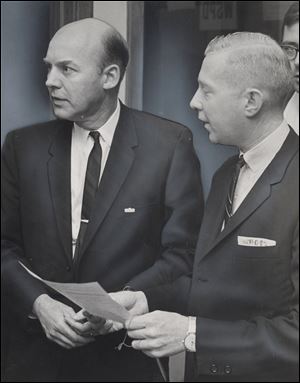
Mayor John Potter campaigns with then-Councilman Andy Douglas in October, 1965. The two Republicans would be colleagues again on the 6th District Court of Appeals.
Judge Potter entered politics in 1951 as a precinct committeeman. Four years later, he was asked to run for municipal judge but declined. He ran unsuccessfully in 1960 for Lucas County Common Pleas Court.
In 1961, he won a seat in what The Blade termed a “Republican landslide” election for City Council. Eight Republicans were elected along with one Democrat, giving the GOP control of council for the first time since 1951, when a “freshman five” class of Republicans was selected.
According to retired Ohio Supreme Court Justice Andy Douglas, who was the top vote-getter in the 1961 council election, their class was dubbed the “sophomore six,” and included himself, Mr. Potter, Thaddeus Walinski, Carlton Siegel, George D. Mayo, and C. Donald Brown, all of whom were political newcomers.
A month after the election, Mr. Potter’s colleagues selected him over the more predictable choice, veteran GOP Councilman Howard Cook, to be mayor — a power council still held at that time.
“There seemed to be a lot of discontent in the city. That had to be obvious in a city that was so Democratic that we elected eight Republicans,” Justice Douglas said. Justice Douglas later would become Judge Potter’s colleague on the Ohio 6th District Court of Appeals.
Justice Douglas said he and Judge Potter were elected to council at a time of uncertainty, citing his own campaign theme at the time, “Have You Had Enough?” But he said Judge Potter was more a practitioner of incremental change, while he, Justice Douglas, was impatient for change.
“He brought a calm, steady hand to the leadership. It was volatile up to that point,” Justice Douglas said. “It may have been a time when the city needed to return to a sense of calm.”
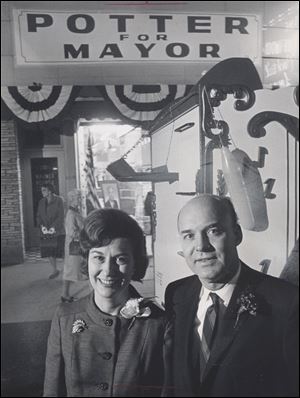
John Potter and his wife, the former Phyllis Bihn, during the 1967 campaign. He lost to Democrat William Ensign, largely over an anti-discrimination housing ordinance that Mayor Potter championed.
An example of Judge Potter’s droll style appeared in a Blade profile shortly after his election, in which he described how he had time for few activities other than going to meetings and working on his law practice.
“I own a set of golf clubs, but I’ve been out so infrequently I could never determine whether I’m enjoying the game,” the new mayor said. “I like to get out and walk, though sometimes — most of the time — I don’t have to take too many steps between strokes.”
He continued as his colleagues’ choice of mayor after the 1963 election, when Republicans retained control of council with six seats, including his own, against three Democrats.
In 1965, he became the first directly elected Toledo mayor in 30 years after voters approved a charter change in 1963, defeating Democrat Ned Skeldon, a Lucas County commissioner. Voters also returned all the incumbent GOP members to council, giving Republicans a 5-3 majority.
Despite the convincing win in 1965, Judge Potter was defeated as mayor in 1967 after he led a referendum for a fair-housing ordinance that made it illegal to discriminate against ethnic minorities when selling or leasing property.
The ordinance was rejected in a 2-1 vote in the 1967 primary election. That same election portended Mayor Potter’s likely defeat, because while he was the leading vote-getter, with 31,810 votes over Democrat William J. Ensign’s 26,100 votes, rival Republican Steven L. Markowski, an opponent of the fair-housing ordinance, collected 22,982 votes, exposing discontent with Mayor Potter in the Republican base.
Mr. Ensign won the general election with his focus on crime in the streets, an understaffed police force, and Mayor Potter’s role in council’s approval of the fair-housing ordinance.
Blade staff writer Pat Jones reported in 1982 that Judge Potter was known for his willingness to “stand up and be counted,” but also displayed, in his support of the housing ordinance, “naivete and great miscalculation.”
“I thought we could explain that [the ordinance] was proper and that it would not project a personal threat, but it was an area with so many emotional entanglements,” Judge Potter said in 1982. “We could have done locally the same thing that state and federal law have done since then.”
Under Mayor Potter, the downtown landscape began to change as the city took steps to revitalize the area around Summit and Cherry streets.
In 1966, the last portion of Adams Township was annexed into Toledo, with the Whitmer area of Washington Township annexed the year before. Between 1960 and 1965, Toledo nearly doubled in area and the population increased by 22 percent. Toledo experienced a surge of industrial growth, with jobs increasing from 181,000 to 244,000, and unemployment dropping from 8.4 percent to 2.7 percent.
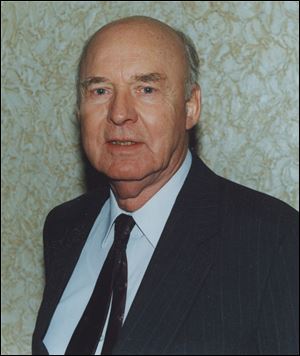
Judge John Potter entered politics in 1951 and went on to serve as mayor and a state and federal judge.
Former Mayor Carty Finkbeiner — then a Republican, later a Democrat — said Judge Potter was deliberate and analytical and “would never let anybody push him in a position that he thought was not an honorable one on the side of the citizens that elected him.”
“He did what most of the thoughtful civic leaders of the community wanted done, but most of the country at that point in time in 1967 were not caught up to that thinking,” Mr. Finkbeiner said about the fair-housing law. “He was an extremely fine, decent, honorable human being.”
Judge Potter was elected in 1969 to the state appellate court. He made an unsuccessful attempt in the 1976 primary to win his party's nomination to the Ohio Supreme Court.
Ben Marsh, 86, a longtime former Republican operative in Maumee who now lives at the Swan Creek Retirement Village, said Judge Potter was sharp of mind right up to the end.
“He remained very, very active here and elsewhere in the community. He had an opinion on every subject, and a joke too. Three weeks ago [at] a men’s discussion group here, John was the speaker and he talked about same-sex marriage from a legal point of view,” Mr. Marsh said.
Judge David Katz, a colleague of the late judge on the Toledo federal bench, said Judge Potter had the ability to dig into issues and conquer problems, and took a practical approach.
“He was a very bright man. He was learned in the law. He was successful and respected in every position he held, whether it was as mayor, state appellate court judge, or federal trial judge,” Judge Katz said. “I would venture to say it would be very difficult to find those who came into contact with him, either as a lawyer or fellow jurist, who would disagree with that assessment.”
Thomas Karol, an assistant U.S. attorney who handled many criminal cases in Judge Potter’s courtroom, said he was a gentleman who treated attorneys, defendants, and courtroom staff with respect. “He was always fair to both sides. He was neutral and balanced. He was very bright. He knew the law. He was fair to the defendants. He listened to the defendants at the time of sentencing. He had a truly real sense of justice,” he said.
Judge Potter grew up in South Toledo and graduated in 1936 from Libbey High School. His father, Charles Potter, was a railroad engineer who was born in Kent County, England, and came to the United States when he was 21.
After high school, Judge Potter studied political science at the University of Toledo, where he graduated with honors in 1940. He continued his education at the University of Michigan, but during his second year of law school, the bombing of Pearl Harbor and World War II interrupted his studies.
He joined the Army in 1942. A few months before he went overseas in 1944, he married the former Phyllis Bihn, a Toledo native whom he met while attending UT.
As a member of the 26th Infantry Division, he fought in the Battle of the Bulge as part of the breakthrough relief column under Gen. George Patton. He returned home in 1945 as a captain, receiving the Bronze Star and four battle stars.
He returned to law school at Michigan, where he graduated in 1946 after being the senior editor of its law review.
From 1947 to 1969, he practiced with a firm that eventually became Boxell, Bebout, Torbet & Potter.
Mrs. Potter died Dec. 11, 2011, and Judge Potter also was preceded in death by a daughter, Kathryn Potter. Surviving are his son, John Potter, Jr.; daughter, Carolyn Hoyt; six grandchildren, and 10 great-grandchildren.
Visitation will be Friday from 3 to 7 p.m. in the Foth-Dorfmeyer Funeral Home, 3815 W. Sylvania Ave. Services will begin at 11 a.m. Saturday at Epworth United Methodist Church, with visitation at the church beginning an hour before.
The family suggests tributes to the Victory Center or a charity of the donor’s choice.
Blade staff writer Mark Reiter contributed to this report.
Contact Tom Troy: tomtroy@theblade.com or 419--724-6058 or an Twitter @TomFTroy.